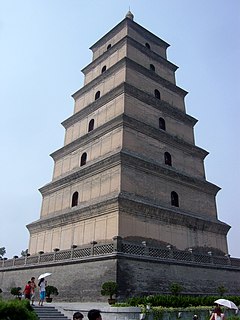
The 7th century is the period from 601 (DCI) through 700 (DCC) in accordance with the Julian calendar in the Common Era. The spread of Islam and the Muslim conquests began with the unification of Arabia by Prophet Muhammad starting in 622. After Muhammad's death in 632, Islam expanded beyond the Arabian Peninsula under the Rashidun Caliphate (632–661) and the Umayyad Caliphate (661–750). The Muslim conquest of Persia in the 7th century led to the downfall of the Sasanian Empire. Also conquered during the 7th century were Syria, Palestine, Armenia, Egypt, and North Africa.
The 630s decade ran from January 1, 630, to December 31, 639.
The 640s decade ran from January 1, 640, to December 31, 649.
The 660s decade ran from January 1, 660, to December 31, 669.

Year 632 (DCXXXII) was a leap year starting on Wednesday of the Julian calendar. The denomination 632 for this year has been used since the early medieval period, when the Anno Domini calendar era became the prevalent method in Europe for naming years.

Year 633 (DCXXXIII) was a common year starting on Friday of the Julian calendar. The denomination 633 for this year has been used since the early medieval period, when the Anno Domini calendar era became the prevalent method in Europe for naming years.

Year 634 (DCXXXIV) was a common year starting on Saturday of the Julian calendar. The denomination 634 for this year has been used since the early medieval period, when the Anno Domini calendar era became the prevalent method in Europe for naming years.

Year 635 (DCXXXV) was a common year starting on Sunday of the Julian calendar. The denomination 635 for this year has been used since the early medieval period, when the Anno Domini calendar era became the prevalent method in Europe for naming years.

Year 652 (DCLII) was a leap year starting on Sunday of the Julian calendar. The denomination 652 for this year has been used since the early medieval period, when the Anno Domini calendar era became the prevalent method in Europe for naming years.

Year 701 (DCCI) was a common year starting on Saturday of the Julian calendar. The denomination 701 for this year has been used since the early medieval period, when the Anno Domini calendar era became the prevalent method in Europe for naming years.

Year 641 (DCXLI) was a common year starting on Monday of the Julian calendar. The denomination 641 for this year has been used since the early medieval period, when the Anno Domini calendar era became the prevalent method in Europe for naming years.

Year 646 (DCXLVI) was a common year starting on Sunday of the Julian calendar. The denomination 646 for this year has been used since the early medieval period, when the Anno Domini calendar era became the prevalent method in Europe for naming years.

Year 656 (DCLVI) was a leap year starting on Friday of the Julian calendar. The denomination 656 for this year has been used since the early medieval period, when the Anno Domini calendar era became the prevalent method in Europe for naming years.

Year 900 (CM) was a leap year starting on Tuesday of the Julian calendar.
Saint Acarius was a monk of Luxeuil Abbey, who became bishop of Doornik and Noyon, which today are located on either side of the Franco-Belgian border.

The Muslim conquest of Egypt, led by the army of 'Amr ibn al-'As, took place between 639 and 646 and was overseen by the Rashidun Caliphate. It ended the seven centuries long period of Roman reign over Egypt that began in 30 BC. Byzantine rule in the country had been shaken, as Egypt had been conquered and occupied for a decade by the Sassanid Iran in 618–629, before being recovered by the Byzantine emperor Heraclius. The caliphate took advantage of Byzantines' exhaustion and captured Egypt ten years after its reconquest by Heraclius.

The Rashidun Caliphate was the first caliphate to succeed the Islamic prophet Muhammad. It was ruled by the first four successive caliphs of Muhammad after his death in 632 CE. During its existence, the empire was the most powerful economic, cultural, and military force in West Asia.
The plague of Amwas, also spelled plague of Emmaus, was a bubonic plague epidemic that afflicted Islamic Syria in 638–639, during the first plague pandemic and toward the end of the Muslim conquest of the region. It was likely a reemergence of the mid-6th-century Plague of Justinian. Called after Amwas in Palestine, the principal camp of the Muslim Arab army, the plague killed up to 25,000 soldiers and their relatives, including most of the army's high command, and caused considerable loss of life and displacement among the indigenous Christians of Syria. The appointment of Mu'awiya ibn Abi Sufyan to the governorship of Syria in the wake of the commanders' deaths paved the way for his establishment of the Umayyad Caliphate in 661, while recurrences of the disease may have contributed to the Umayyad dynasty's downfall in 750. Depopulation in the Syrian countryside may have been a factor in the resettlement of the land by the Arabs unlike in other conquered regions where the Arabs largely secluded themselves to new garrison cities.
The First Battle of Dongola was a battle between early Arab-Muslim forces of the Rashidun Caliphate and the Nubian-Christian forces of the Kingdom of Makuria in 642. The battle, which resulted in a Makurian victory, temporarily halted Arab incursions into Nubia and set the tone for an atmosphere of hostility between the two cultures until the culmination of the Second Battle of Dongola in 652.
The siege of Emesa in 638 was laid by a coalition force of Arab Christian tribes from Jazira which mustered by Heraclius in an attempt to stimy the losses of Byzantine territories due to rapid expansion of the Rashidun Caliphate in the Levant.













